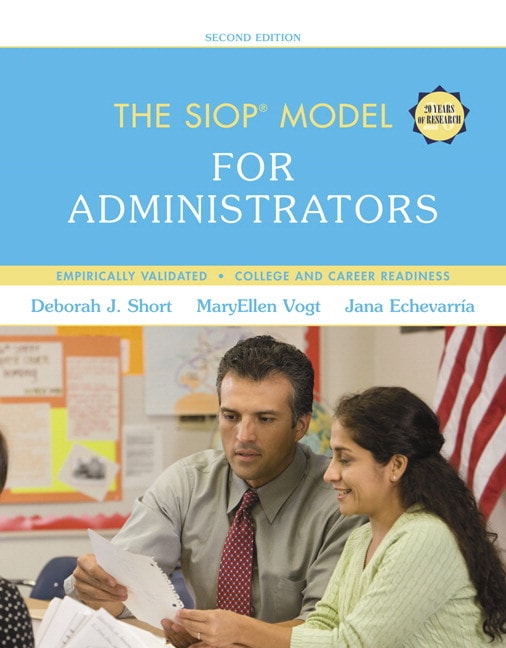
SIOP Model for Administrators, The, 2nd edition
- Deborah J. Short
- , MaryEllen Vogt
- , Jana Echevarria

- Study simpler and faster
Use flashcards and other study tools in your eTextbook
- Find it fast
Quickly navigate your eTextbook with search
- Stay organized
Access all your eTextbooks in one place
- Easily continue access
Keep learning with auto-renew
Brief Contents
1. Getting to Know English Learners
2. Learning a Second Language
3. Understanding the SIOP Model from an Administrator's Perspective
4. Getting Started with SIOP Model Implementation
5. Refocusing Your School with SIOP
6. Frequently Asked Questions: Getting Started with SIOP
Appendix A: SIOP (Sheltered Instruction Observation Protocol)
Appendix B: Sample Handout for Staff Meeting
Appendix C: Research on the SIOP (Sheltered Instruction Observation Protocol) Model
Appendix D: The SIOP Checklist
Appendix E: Action Plan for SIOP® Model Implementation
Glossary
References
Index
Detailed Contents
1. Getting to Know English Learners
Who Are English Learners?
English Learner Demographics
Diverse Characteristics Among English Learners
How Do English Learners Perform in School?
Academic Performance of English Learners
How Should We Serve English Learners in School?
English Learner Identification
Language Support Programs
ESL/ELD/Sheltered programs
Bilingual programs
Newcomer programs
Levels of Language Proficiency
Staffing
What Is the SIOP® Model?
Key Points Summary
Reflect and Apply
2. Learning a Second Language
Acquiring a Second Language
The Language Demands of School
Speaking and Listening
Reading
Writing
Vocabulary Development
Social and Academic Language
Time Required to Learn a New Language
Factors That Influence Second Language Acquisition
Age
Aptitude
Motivation
Personality
First Language Development
Socio-psychological
Quality of Instruction
Using Technology to learn a Second Language
Research Evidence About Second Language Learning
Meeting the Needs of Every English Learner
Long-Term English Learners
Struggling English Learners and RTI
The Value of Bilingualism
Cognitive
Socio-emotional
Academic
Key Points Summary
Reflect and Apply
3. Understanding the SIOP Model from an Administrator's Perspective
The Role of an Administrator
SIOP Model Research
The CREDE SIOP Model Design Study
Lela Alston Elementary School Program Evaluation
The New Jersey SIOP Quasi-Experimental Study
The CREATE SIOP Experimental Study
SIOP Professional Development Program
The SIOP Model in the Classroom
SIOP Teachers in Action
Lesson Preparation
Building Background
Comprehensible Input
Strategies
Interaction
Practice & Application
Lesson Delivery
Review & Assessment
Observation Tools
Key Points Summary
Reflect and Apply
4. Getting Started with SIOP Model Implementation
Examine the Academic Performance of English Learners
Consider the Teachers' Credentials for Instructing English Learners
Set Goals for SIOP Implementation
Seek Required Approvals
Establish Responsibilities
Secure Funding
Plan Initial SIOP Staff Development
Create a SIOP Coaching Plan
Plan Ongoing SIOP Professional Learning
Provide Instructional Leadership
Consider Planning a Formative Evaluation
Construct a Realistic Timeline
Key Points Summary
Reflect and Apply
5. Refocusing Your School with SIOP
Using SIOP to Organize for Change
Reducing Competing Initiatives
Aligning SIOP with the Common Core and Other State Standards
Administrative Leadership with SIOP Implementation
The Ongoing Role of the Administrator During SIOP Implementation
Taking a Participatory Role in SIOP Implementation
SIOP and Professional Learning Communities (PLCs)
Critical Friends as Peer Coaches
Viewing SIOP Professional Learning as an Ongoing Process
Ongoing SIOP Data Collection During Implementation
Using the SIOP Protocol During Observations of Lessons
Effective Differentiated Instruction in the Classroom
Sustaining SIOP Over Time
Key Points Summary
Reflect and Apply Chapter
6. Frequently Asked Questions: Getting Started with SIOP
General SIOP Questions
Who can implement SIOP?
Is SIOP only for English learners?
Isn't SIOP just good instruction?
What is the relationship between SIOP and Culturally Responsive Teaching?
What if there are only a few English learners in a classroom?
As an administrator, what is the most important thing I should keep in mind as we get started with SIOP?
Questions about Getting Started with SIOP in the Classroom
How should teachers start using SIOP in their classrooms?
Do teachers need to incorporate all 30 SIOP features in every lesson?
What if a teacher has students who can't speak any English? Will SIOP help?
How long will it take for teachers to become effective with SIOP?
How can teachers use the SIOP protocol?
Once teachers have read the core text and tried out some of the components, how do they deepen their SIOP knowledge?
Questions about School-wide Implementation of the SIOP Model
How should we get started with our school's implementation?
Who should receive SIOP professional development?
What should SIOP professional learning look like?
How can the SIOP protocol be used school-wide?
What should we do about reluctant or resistant teachers?
With whom should we collaborate during SIOP implementation?
What does it mean to be a high-implementing SIOP teacher?
Is SIOP compatible with the Common Core State Standards?
SIOP is a lesson planning and delivery system for teachers, but what about student outcomes?
As an administrator, where can I get some assistance?
How can the SIOP protocol be used by researchers and program evaluators to measure teachers' level of SIOP implementation with the protocol?
Key Points Summary
Reflect and Apply
Appendixes
Appendix A: SIOP (Sheltered Instruction Observation Protocol)
Appendix B: Sample Handout for Staff Meeting
Appendix C: Research on the SIOP (Sheltered Instruction Observation Protocol) Model
Appendix D: The SIOP Checklist
Appendix E: Action Plan for SIOP® Model Implementation
Glossary
References
Index